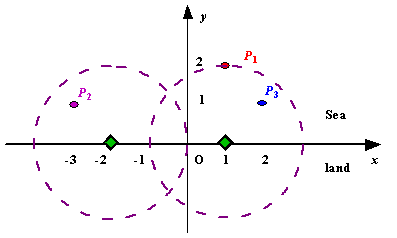Radar Installation
| Time Limit: 1000MS | Memory Limit: 10000K | |
| Total Submissions: 52444 | Accepted: 11792 |
Description
Assume the coasting is an infinite straight line. Land is in one side of coasting, sea in the other. Each small island is a point locating in the sea side. And any radar installation, locating on the coasting, can only cover d distance, so an island in the sea can be covered by a radius installation, if the distance between them is at most d.
We use Cartesian coordinate system, defining the coasting is the x-axis. The sea side is above x-axis, and the land side below. Given the position of each island in the sea, and given the distance of the coverage of the radar installation, your task is to write a program to find the minimal number of radar installations to cover all the islands. Note that the position of an island is represented by its x-y coordinates.

Figure A Sample Input of Radar Installations
We use Cartesian coordinate system, defining the coasting is the x-axis. The sea side is above x-axis, and the land side below. Given the position of each island in the sea, and given the distance of the coverage of the radar installation, your task is to write a program to find the minimal number of radar installations to cover all the islands. Note that the position of an island is represented by its x-y coordinates.

Figure A Sample Input of Radar Installations
Input
The input consists of several test cases. The first line of each case contains two integers n (1<=n<=1000) and d, where n is the number of islands in the sea and d is the distance of coverage of the radar installation. This is followed by n lines each containing two integers representing the coordinate of the position of each island. Then a blank line follows to separate the cases.
The input is terminated by a line containing pair of zeros
The input is terminated by a line containing pair of zeros
Output
For each test case output one line consisting of the test case number followed by the minimal number of radar installations needed. "-1" installation means no solution for that case.
Sample Input
3 2 1 2 -3 1 2 1 1 2 0 2 0 0
Sample Output
Case 1: 2 Case 2: 1
题意:
给出 n(1 ~ 1000),d,后给出 n 个坐标点,问在 x 轴上选择一些点,这些点能覆盖周围半径 d 以内的地方,问最少在坐标轴上建立几个点,使之能覆盖所有给出的点,如果不能则输出 -1。
思路:
贪心。找出最少的点数,使之覆盖所有的区间。对于每个给出的点,在半径 d 以内都会在 x 轴上有一个区间范围,找出所有点的区间范围之后。题目变为求解找到最少的点使之所有区间得到覆盖的问题。先对所有区间范围的左坐标由小到大排序一遍,维护最右的端点值,如果下一个区间的左边大于当前右端点值,则需要增加一个点,且维护的最右端点值变为该区间的右端点值。还有一个值得注意的地方就是,如果这个区间的右端点值小于当前维护的右端点值,则需要更新这个端点值。如果在计算区间的时候,遇到 y > d 的则可以判断为 -1 输出。
AC:
#include <cstdio>
#include <cstring>
#include <algorithm>
#include <cmath>
using namespace std;
typedef struct { double a, b; } node;
node no[1005];
double dis (double a, double c) {
double res = c * c - a * a;
if(res < 0) return -1;
return sqrt(res);
}
bool cmp (node a, node b) { return a.a < b.a; }
int main() {
int n, t = 0;
double c;
while (~scanf("%d%lf", &n, &c) && n && c) {
int temp = 0;
memset(no, 0, sizeof(no));
for (int i = 0; i < n; ++i) {
double x, b;
scanf("%lf%lf", &x, &b);
if (b > c) temp = 1;
else {
double a = dis(b, c);
no[i].a = x - a;
no[i].b = x + a;
}
}
printf("Case %d: ", ++t);
if (temp) printf("-1\n");
else {
sort(no, no + n, cmp);
int ans = 1;
double ee = no[0].b;
for (int i = 1; i < n; ++i) {
if (no[i].b < ee) ee = no[i].b;
else if (no[i].a > ee) {
++ans;
ee = no[i].b;
}
}
printf("%d\n", ans);
}
}
return 0;
}





















 571
571

 被折叠的 条评论
为什么被折叠?
被折叠的 条评论
为什么被折叠?








